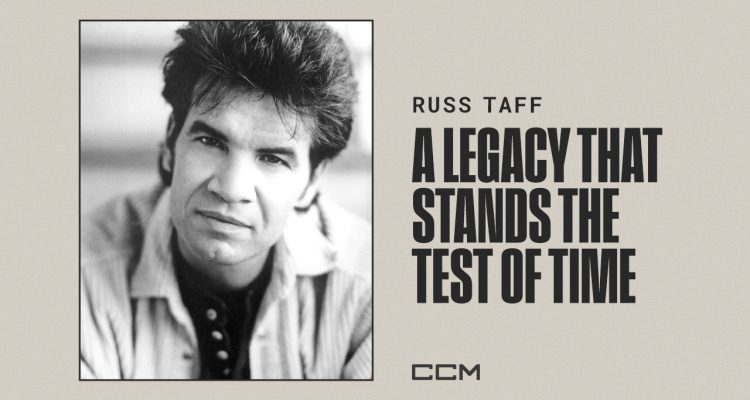My dad had a great collection of T-shirts. One of his favorites was a royal blue tee with two medals printed on the chest. It was a concert tee he’d bought around 1985 when he went to see one of his favorite contemporary Christian artists, Russ Taff. And I assure you, he wore that shirt at least once a week until the blue faded and the threads were bare.
But I truly discovered the man Billboard Magazine once called “the single most electrifying voice in Christian music” for myself through his 1987 self-titled album, Russ Taff. While it opens with an upbeat, R&B-infused celebration of the coming rapture with Shake and includes a few up-tempo rockers like Living on the Edge of Time and the synth-heavy Higher, don’t be fooled. Much of the album is laced with urgency and anxiety, as well as melancholy, pain, and displacement. From the sinking desperation of Charlie Peacock’s Down in the Lowlands to the anguished plea of Believe in Love and the yearning of Breathe Life Into Me, it’s an album that doesn’t shy away from raw emotion.
And then there’s This Love Is Strong, which Taff co-wrote with his wife Tori, and collaborator James Hollihan with heartbreaking lyrics like “we circle like opponents, sparring with the blame.” More visual imagery, this time of spouses turned emotional combatants as they contend with personal demons. Demons that Russ has been very open about fighting.
For a Christian album, this was heavy stuff—themes I, as a teenager, was only beginning to comprehend. Throughout his career, Russ Taff has found a way to weave his own pain into beautiful, sometimes gut-wrenching music about struggle, redemption, yearning, faith, and forgiveness.
This year, over four decades since his first solo album, Russ has released Cover Story, a soul-stirring gritty gumbo of gospel, R&B, and country, seasoned with a touch of Bourbon Street jazz and Delta blues. Executive produced by the legendary contemporary Christian artist Steve Taylor and produced by John Mark Painter (Fleming and John), Cover Story is a collection of, quite frankly, unexpected reinterpretations of other artists’ songs. From the opening track, Tear This Building Down—a contemporary reimagining of Delta blues legend Blind Willie Johnson—to surprising takes on Depeche Mode, Duran Duran, U2, and even Prince, there is nothing predictable about this album, which is part of its magic.
Throughout Cover Story, Russ’s raw, honest vocals send chills down my spine as he lays everything out on the table. All the pain. All the struggles. All the traumas. It’s audible. And yet, because it’s Russ, he makes it beautiful. This is an unapologetic collection of songs that say, No, everything isn’t alright. And we shouldn’t be afraid of that—not even on a gospel record. Life is a struggle, even for believers. Faith is a struggle. God knows.
As Russ sings in his cover of The National’s song Demons:
“Oh, every day I start so great, and then the sunlight dims.
The less I look, the more I see the pythons in the limbs.”
Cover Story is the result of a long career—fueled, maybe, as much by pain and trauma as it is by passion, faith, and undeniable talent. In a world desperate to know that there is hope, isn’t it much more effective for that message to be delivered by an artist who’s experienced that hope, felt it slipping away, been pulled down, and by grace alone, managed to claw his way back up the mountain to reclaim it?
As I find myself sliding inescapably toward 50—and with Dad and that T-shirt no longer around—I find myself in a pensive season. Reliving mistakes, failures, regrets, and pains—both those I’ve felt and those I’ve caused. But at some point, you have to accept that you can’t change them. But you should learn from them. Some people even figure out how to use them—turning pain into power, using it to ease the pain of others. We usually call them artists, and as Cover Story reminds me, Russ Taff continues to embody that very idea.
Russ’s music is unquestionably his ministry, even if it’s also been an arduous journey. Russ Taff is proof that even a man at war with his own demons can be used to save others from theirs. And Cover Story proves, his songs can still mine emotions out of listeners they may not have known they possessed.


Leave a Reply
You must be logged in to post a comment.